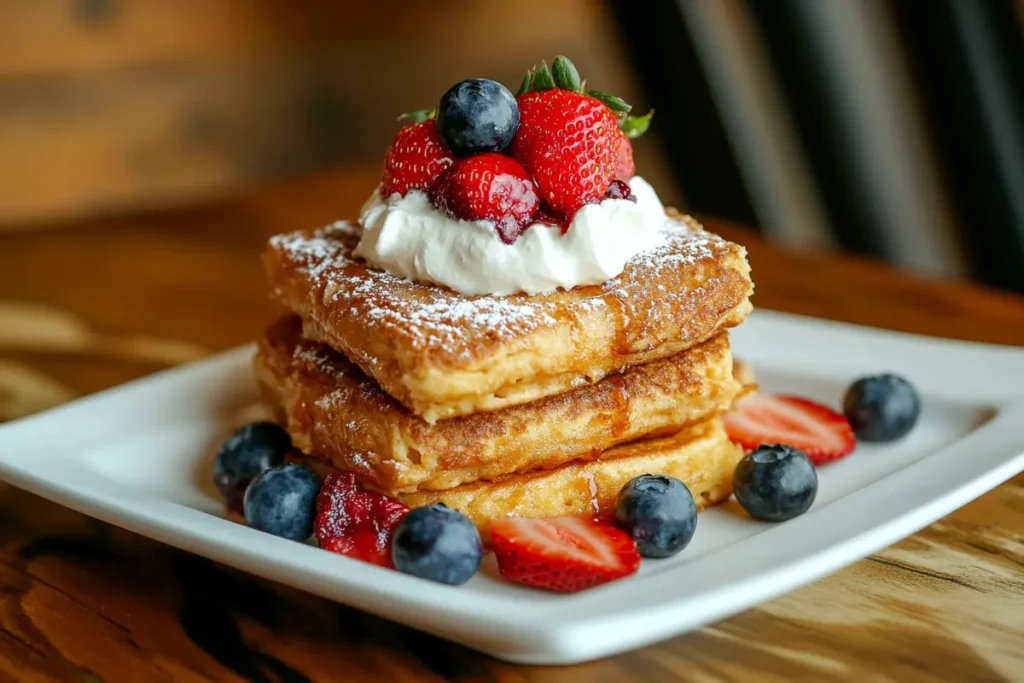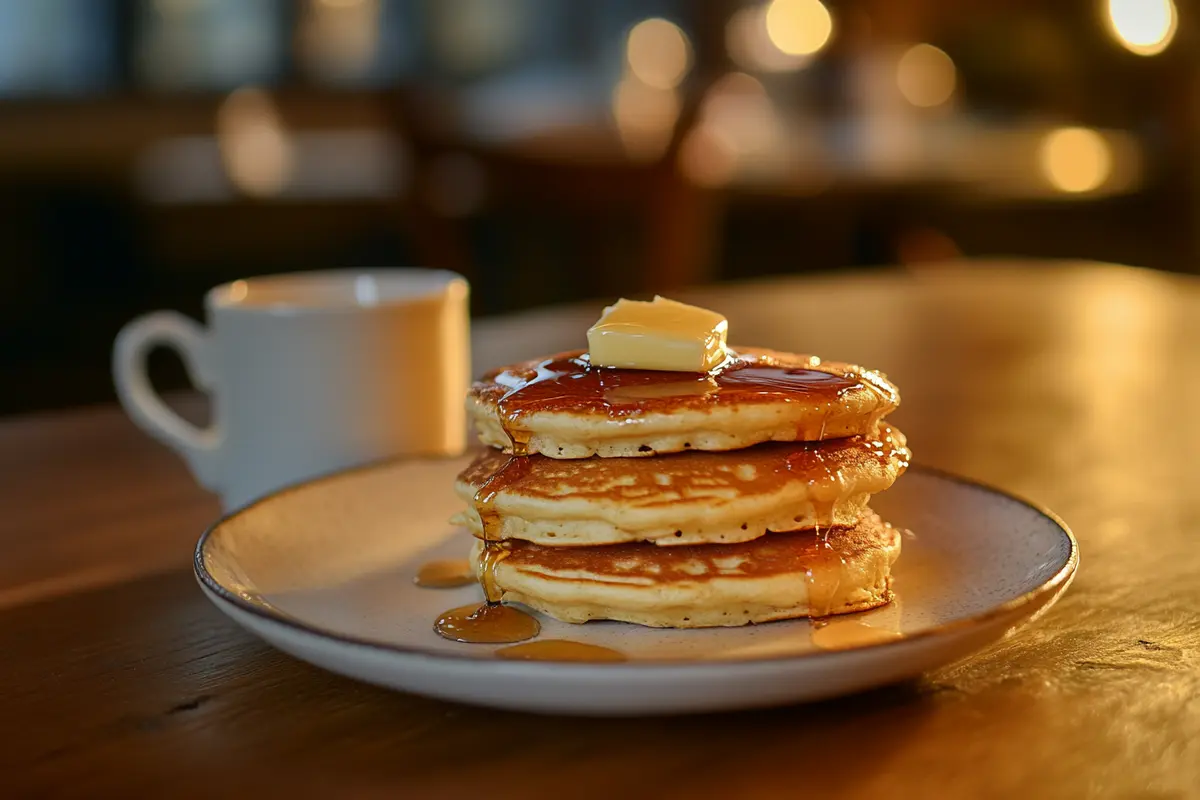Why are my flapjacks not fluffy? This article reveals the top reasons your flapjacks turn out dense and provides simple tips to make them light and airy every time.
Why Are My Flapjacks Not Fluffy?: Understanding the Issue
Many people wonder, “why are my flapjacks not fluffy?” It’s a common kitchen dilemma. Dense, flat flapjacks are disappointing. However, understanding the causes can solve the problem. Several factors can lead to less than fluffy results. These include incorrect ingredient ratios, improper mixing techniques, and incorrect pan temperatures. Let’s explore these issues. We’ll also offer simple fixes to help you bake light and airy flapjacks.
Key Ingredients: The Foundation of Fluffy Flapjacks
The ingredients you use play a vital role in the final texture. Therefore, understanding each one’s function is important. Using old baking powder can prevent fluffy results. Also, using the wrong type of flour can make flapjacks dense. Here’s how each key component helps achieve that desired fluffiness:
The Role of Baking Powder and Baking Soda
Baking powder and baking soda are leavening agents. They create gas bubbles, resulting in fluffy flapjacks. Therefore, using the correct amount is essential. First, check the expiration date on your baking powder. If it’s old, it may not work well. Second, baking soda needs an acid to react. So, make sure to use buttermilk or yogurt to activate it. Adding too much of either can cause a metallic taste. On the other hand, too little will result in flat flapjacks.
Flour Selection Matters
The type of flour you use significantly affects texture. All-purpose flour works well. However, avoid using too much. Too much flour results in heavy flapjacks. Also, some people prefer using cake flour for lighter results. Using a combination of flours can create a good balance. This therefore is an important detail to consider.
The Importance of Liquids
The liquid in your batter is also important. The right amount of liquid makes the batter pourable. It also helps hydrate the flour. Too little liquid results in a thick, dense batter. In contrast, too much liquid makes them flat. Milk or buttermilk work well in flapjack batter. Buttermilk adds a slight tang and helps with leavening. Additionally, you can use yogurt for a similar effect.
Eggs and Fat: Adding Richness
Eggs add structure and richness. Fats, like melted butter, add moisture. These help with the overall texture and flavor. Using cold eggs can negatively affect the batter. Also, the fat should be melted and slightly cooled. This ensures even incorporation and avoids cooking the eggs.
Mixing Techniques: The Secret to Fluffy Flapjacks
The way you mix your batter has a large impact on texture. Overmixing can develop the gluten in the flour. This leads to tough, not fluffy, flapjacks. Therefore, proper mixing is critical.
Gentle Mixing is Key
First, mix the wet and dry ingredients separately. This helps achieve even distribution. Then, gently combine them until just mixed. Lumps are okay; do not overmix. Too much mixing will result in a dense final result. Specifically, avoid using electric mixers for the final mix.
Resting the Batter
Letting the batter rest for 5-10 minutes is important. This allows the gluten to relax. Consequently, this helps create a tender, fluffy result. This step is often overlooked, yet it makes a large difference.
The Role of Air Bubbles
Lightly folding the batter incorporates air bubbles. These are what make your flapjacks light and fluffy. Stirring vigorously removes these air bubbles, leading to a dense result. However, do not over mix even while trying to incorporate air bubbles.
Why Are My Flapjacks Not Fluffy?: Pan Temperature and Cooking
Pan temperature significantly affects the final texture. If the pan is too hot, the flapjacks will burn. If the pan is not hot enough, the flapjacks will be flat and pale. Hence, managing the temperature is essential for good fluffiness.
Achieving the Ideal Heat
Use medium-low heat for cooking flapjacks. This allows them to cook evenly without burning. Use a non-stick pan for the best results. If you don’t have one, use a little butter or oil. A hot pan helps the edges crisp up nicely. However, if the pan is too hot, they will burn and the center will be uncooked.
The Importance of a Proper Flip
Wait until you see bubbles forming on the surface of the batter. This means it’s time to flip them. Use a thin spatula for flipping. Flip them quickly and smoothly. Then, cook the other side for another 1-2 minutes. This step ensures that the flapjacks cook evenly on both sides.
Avoiding Flat Flapjacks During Cooking
Do not press down on the flapjacks while cooking. This will push out the air and result in flat results. Furthermore, avoid overcrowding the pan. Overcrowding will decrease the pan temperature and cause uneven cooking. Cook in batches to ensure that each flapjack is properly heated.
Addressing Common Mistakes That Affect Fluffiness
Even with the right ingredients and techniques, things can still go wrong. Consequently, let’s look at some common mistakes that might prevent fluffy flapjacks:
Expired Leavening Agents
Expired baking powder or baking soda won’t work well. Always check the date and replace them as needed. Using fresh ingredients is crucial for the best results. This ensures proper rise and texture.
Overcrowding the Pan
Do not crowd the pan while cooking. Overcrowding will lower the pan’s temperature. This can prevent flapjacks from cooking properly. Specifically, cook in batches and give each one enough space.
Overmixing the Batter
Overmixing develops gluten and makes the batter tough. Gently mix until just combined. Lumps are okay. Overmixing is a very common error. Accordingly, be cautious of this.
Incorrect Pan Temperature
Pan temperature is very important. If it’s too hot, they will burn. If it’s too low, they’ll be flat and pale. Medium-low heat is best for evenly cooked, fluffy flapjacks.
Improper Batter Consistency
The batter should be thick but pourable. Too thick, and they will be dense. Too thin, and they will spread out. Adjust the liquid as needed to get the correct consistency. Ultimately, the right batter consistency is a must.
Simple Tweaks for Extra Fluffiness
Sometimes, a few extra steps can help you achieve very fluffy flapjacks. These little adjustments can make a big difference.
Using Carbonated Water or Club Soda
Adding a splash of carbonated water or club soda can help. These liquids add extra lift to the batter. Basically, this will make them even lighter. This works well in conjunction with baking soda and baking powder.
Whipping Egg Whites Separately
Whipping the egg whites until stiff and folding them in gently is very effective. The whipped egg whites add air. This makes the flapjacks much lighter. This technique adds an extra level of fluffiness. Nevertheless, be careful not to overmix.
Adding a Little Bit of Acid
Acids such as lemon juice or vinegar can help activate the baking soda. Add just a teaspoon of lemon juice to your batter. The results can be more fluffy flapjacks.
Sifting Dry Ingredients
Sifting dry ingredients before adding them to the wet ones also helps. This removes any clumps. Furthermore, it ensures that the ingredients are evenly distributed. This step also adds a little air to the flour.
Experimenting With Flavor Additions

While focusing on fluffiness, you can also add flavor. There are many ways to enhance your flapjacks.
Adding Fruits and Berries
Add fresh or frozen berries to the batter. Also, sliced bananas, or small pieces of apple are great. These add flavor and moisture. Avoid adding too much fruit as they will become heavy.
Incorporating Spices and Extracts
Spices like cinnamon, nutmeg, or cardamom can add warmth. Vanilla or almond extract are also nice flavor additions. Use just a teaspoon of extract or a quarter teaspoon of spices. Too much can affect the batter.
Chocolate Chips and Nuts
Chocolate chips are always a great option. Also, adding chopped nuts adds flavor and texture. However, make sure not to add too much. It may cause the flapjacks to cook unevenly.
Troubleshooting: Why Are My Flapjacks Still Not Fluffy?
Even after trying the tips above, some may still struggle. Here are more potential issues that might be the reason for your flapjacks not fluffy:
Checking Ingredient Proportions
Double-check ingredient measurements. Too much or too little of one ingredient can make a big difference. Use measuring cups and spoons. Do not estimate by eye. Accuracy is key for baking.
Reevaluating Leavening Agents
If your baking powder or baking soda is old, your flapjacks might not rise. Buy fresh ones for the best results. Specifically, check the expiration date each time you use them.
Adjusting Mixing Methods
If you overmix your batter, this could be the cause. Make sure to only mix until just combined. Also, do not stir too vigorously. Gentle handling of the batter is necessary.
Assessing Pan and Heat
The type of pan you use and the temperature of the heat are important. Try a non-stick pan and medium-low heat. If your pan is not non-stick, use a little butter or oil. Also, preheat your pan before adding the batter.
Why Are My Flapjacks Not Fluffy: The Recap
Making fluffy flapjacks is a combination of the right ingredients, techniques, and careful cooking. You need the proper ingredient ratios, careful mixing, and correct pan temperatures. By paying attention to the details, you can achieve that fluffy result every time. Therefore, practice and a little troubleshooting will help improve your flapjack baking. Remember these important points to bake better flapjacks.
Common Problems and Solutions
Remember the common mistakes we discussed. Use fresh leavening agents. Also, do not overmix the batter. Make sure your pan is at the right temperature. Undoubtedly, paying attention to details will help you succeed.
Mastering the Flapjack Recipe
Experiment and practice. Baking is a science, and practice makes perfect. Subsequently, you’ll find the right techniques for your kitchen. Enjoy making fluffy flapjacks for breakfast or any time. Eventually, you will master the art of making flapjacks.
FAQs: Addressing Your Questions
Here are some frequently asked questions about flapjacks to help you further:
Why are my flapjacks still soft?
If your flapjacks are still soft, it is often due to undercooking or too much liquid in the batter. First, ensure your pan is at the right temperature. Then, cook them a little longer. Also, check the consistency of your batter. Specifically, it should be thick but still pourable. Adding a little more flour might help, too. Ultimately, make sure not to press down on them while cooking.
What happens if you put too much syrup in flapjacks?
Too much syrup can make flapjacks soggy. The syrup will penetrate them and make them lose their texture. It’s better to add syrup just before serving. This way they remain fluffy. Control the amount of syrup you pour. Add it slowly. This is the best method to avoid soggy flapjacks. Thus, adding syrup right before serving is the best choice.
How to make flapjacks more solid?
To make flapjacks more solid, you can add a little more flour to your batter. Also, you can cook them for a bit longer. Ensure you are using the correct flour. All-purpose flour works best for a solid texture. Also, avoid overmixing your batter. This also will help to make them more firm.
Why is my flapjack not chewy?
If your flapjacks are not chewy, you may need more gluten development. You can achieve this by mixing the batter just a bit more. Use all-purpose flour, not cake flour. Also, a little more butter or fat can add a touch of chewiness. Be careful not to overmix or they may become tough. Meanwhile, finding the perfect balance can help to get that chewy texture you want.

